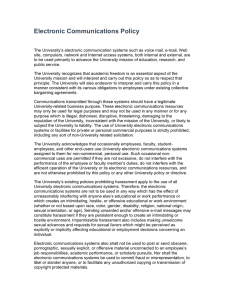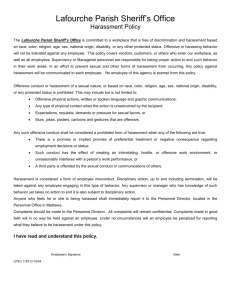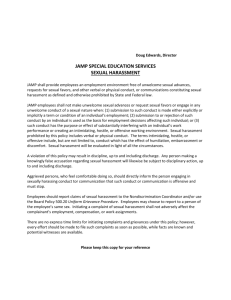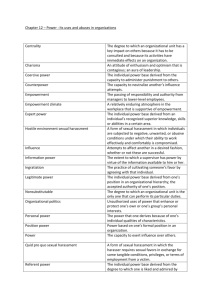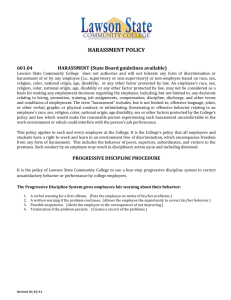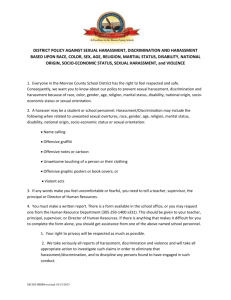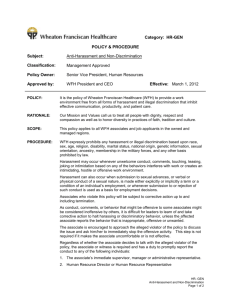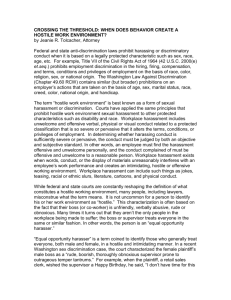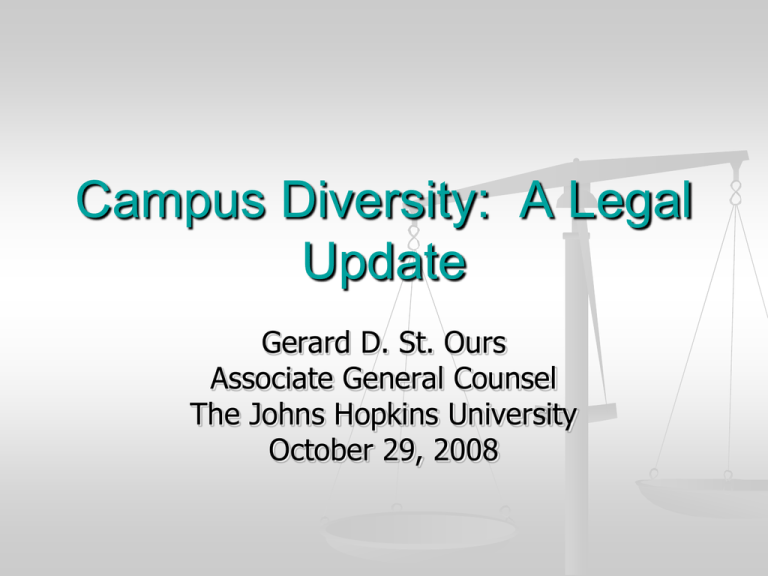
Campus Diversity: A Legal
Update
Gerard D. St. Ours
Associate General Counsel
The Johns Hopkins University
October 29, 2008
Anti-Harassment Polices and
Speech
Example 1: “all forms of sexual harassment are
prohibited, including ... expressive, visual, or
physical conduct of a sexual or gendermotivated nature, when ... (c) such conduct has
the purpose or effect of unreasonably interfering
with an individual's work, educational
performance, or status; or (d) such conduct has
the purpose or effect of creating an intimidating,
hostile, or offensive environment.”
Anti-Harassment Polices and
Speech
Example 2: “For purposes of this policy,
harassment is defined as: (a) any type of
behavior which is based on gender, . . .
race, . . . national origin, . . . sexual
orientation . . . , that (b) is so severe or
pervasive that it interferes with an
individual’s work or academic performance
or creates an intimidating, hostile or
offensive working or academic
environment.”
DeJohn v. Temple University
First Amendment challenge to Temple’s sexual
harassment policy
DeJohn, a grad student in the Military History
department, claimed the policy was facially
overbroad because it inhibited his free
expression in class concerning women in combat
and women in the military
Court agrees with DeJohn and grants injunctive
relief
The Overbreadth Doctrine and
Temple’s Policy
A regulation of speech must be struck down on
if on its face it covers expression that is
protected by the Constitution - - that is, it must
be narrowly drawn so as not to reach protected
speech
According to the Court, the Temple policy’s
focus on the speaker’s motivation, coupled with
use of “hostile,” “offensive,” and “gendermotivated” is on its face “sufficiently broad and
subjective” as to conceivable cover any “gendermotivated” speech, the “content of which
offends someone.”
Where is the severity and
pervasiveness?
Answer: it is not there, and that, in the
eyes of the court, made the Temple policy
fatally flawed: “Absent any requirement
akin to a showing of severity or
pervasiveness - - that is, a requirement
that the conduct objectively and
subjectively creates a hostile environment
or substantially interferes with an
individual’s work - - the policy provides no
shelter for core protected speech.”
Can’t a university prevent
harassment before it happens?
Well, of course, but the institution’s policy
should be qualified by the “severe and
pervasive” standard
Private (JHU) vs. Public (Temple)
Conduct short of legal harassment?
Training
Reprimand?
Context matters: workplace, classroom, time,
place and manner
Other cases
College Republicans at San Francisco University
v. Reed
On campus Anti-terrorism rally included visual
displays depicting Hamas and Hezbollah flags on
butcher paper; flags had the word “Allah” in Arabic
script; at one point, students put the paper flags on
the ground and stepped on them; heated argument
ensued
Student code: “Students are expected to be good
citizens and to engage in responsible behaviors that
reflect well upon their university, to be civil to one
another and to others in the campus community . . .”
Other cases
Student complaint: trekking over “Allah” violated
student code; incitement to violence; created a hostile
environment; incivil
USF hearing panel dismissed the charges
College Reuplicans still brought suit
Court does not strike down code provisions that are tied
to threats/endangerment of health/safety
However, Court enjoins USF against enforcement of the
civility provision.
Cannot prohibit speech merely because it is offensive
University context
“core political expression”: Expressive conduct provoked intense
debate and was disrespectful and offensive to many; but “it was
these very characteristics that were critical to its effectiveness.”
Other cases
Roberts v. Haragan (Tex. Tech Law school case)
Student wanted to give speech and pass out literature
expressing his religious and political views that
“homosexuality is a sinful, immoral and unhealthy
lifestyle.”
Court strikes down speech code and “prior
permission” requirements because they were not
narrowly tailored and were overbroad
School granted permission, but student sued anyway
- - Court considered various aspects of school policy
regarding forum, prior permission, etc.
Policy Language
A. Conduct that disrupts or interferes with the orderly operation of
teaching and research, or with other lawful or authorized activities.
B. Conduct that causes, or can be reasonably expected to cause, or
threatens physical harm to a person.
C. Physical or verbal threats against or intimidation of any person
which results in limiting her/his full access to all aspects of life at
the university.
D. Conduct or a pattern of conduct in which a person approaches or
pursues another person with intent to place the person in fear of
physical harm or with intent to harass or to intimidate the person.
E. Conduct that violates the university’s hazing policy, or other
conduct or a pattern of conduct that harasses a person or group.
A Few More Cases
Instructor’s posting of cartoons on office door indicating
college “fired the handicapped” and depicting
administrators as members of the KKK was defamatory
and not protected speech. McBearty v. Ky Community
and Tech. College Sys.
Employee’s invitation to student to pose for swim suit
calendar was not sexual harassment and did not present
grounds for termination. Va. Tech v. Queensberry
Elderly campus resident’s pattern of asking female
students out and sending cards and gifts does not
constitute sexual harassment; subjective response of
students that this was SH fell short of “reasonable
women” standard; conduct was “annoying and
bothersome” but not SH. Godfrey v. Princeton
Theological Seminary
DOE Letter on Use of Race in
Admissions
August 28, 2008 DOE Letter: OCR lists parameters on use of race in
admissions:
Use of race must be essential to an institution’s mission and stated
goals;
The diversity sought by the postsecondary institution must be broader
than mere racial diversity;
Quotas are impermissible;
Providing individualized consideration is paramount and there must be
no undue burden on other-race applicants;
Before using race, there must be serious good faith consideration of
workable race-neutral alternatives; and
Periodic reviews are necessary and the use of race must have a logical
end point.
Review: Constitutional and Statutory
Limitations
Equal Protection Clause
Title VII
provides that "no State shall… deny to any person
within its jurisdiction the equal protection of the
laws."
Prohibits discrimination in employment on the basis of
race, gender, religion and national orgin
Title VI
Prohibits discrimination in any program that receives
federal funds
Strict Scrutiny and Narrow Tailoring
“It is well established that when the government
distributes burdens or benefits on the basis of individual
racial classifications, that action is reviewed under strict
scrutiny. . . . ‘[R]acical classifications are simply too
perniciious to permit any but the most exact connection
between justification and classification.’” Parents
Involved in Community Schools v. Seattle School District
No. 1, 127 S.Ct. 2738, 2751-52 (2007).
Remedial justification (remedying the effects of past
intentional discrimination)
Diversity
Brief Review of Grutter
Supreme Court confirms that there is a
compelling interest in higher education to
expose students to “widely diverse people,
culture, ideas and viewpoints,” and this
interest permits universities to adopt
narrowly tailored race conscious programs
in admissions.
Student Admissions
Programs must be designed to ensure
individualized review of applicants and their
diversity attributes, which should include:
Non-mechanical, full-file review of applicants;
Flexible review entailing consideration of “all
pertinent elements of diversity in light of the
particular qualifications of each applicant, and to
place them on the same footing for consideration,
although not necessarily according them the same
weight;” and
Protection against burdens on individuals who do not
benefit from the race-conscious policies.
Fisher v. Texas
Federal court denies request to require UT to re-evaluate
applicants for admission without considering race; cites
Grutter
For students who are not admitted under the Texas “Top
10%” law, UT applies a multi-factor scoring process;
students are scored on two essays, and based on
subjective assessment of several factors: “demonstrated
leadership qualities, extracurricular activities, honors and
awards, work experience, community service, and
special personal circumstances.” Sub-factors under
"special circumstances:" “socioeconomic status of the
family and the school, a single-parent home, whether
languages other than English are spoken at home, family
responsibilities, and race.” Readers are trained to review
applications under consistent guidelines/methodology.
Q & A/Discussion

